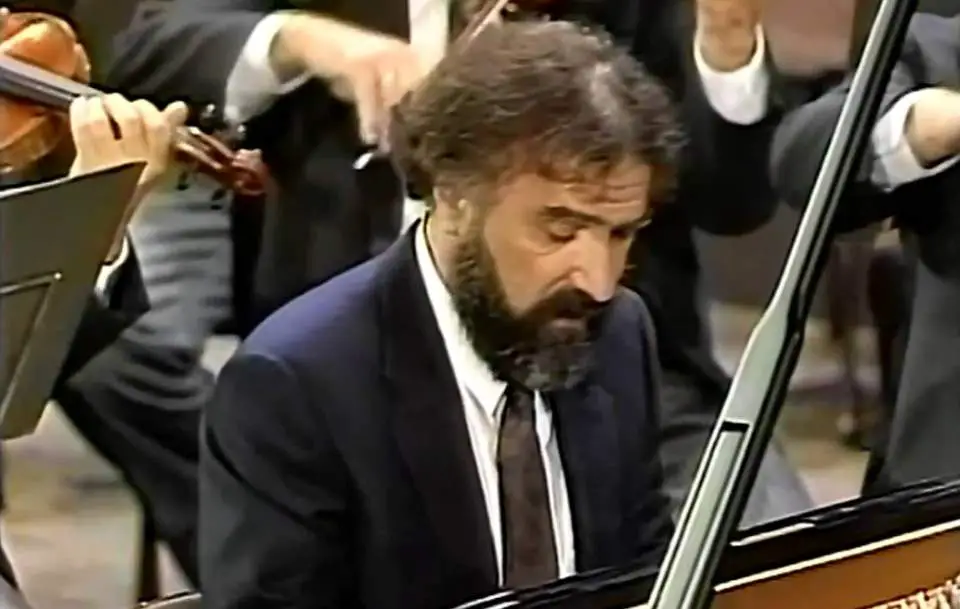Accompanied by the Wiener Philharmoniker (Vienna Philharmonic Orchestra), the Romanian concert pianist Radu Lupu performs Wolfgang Amadeus Mozart’s Piano Concerto No. 23 in A major (K. 488). Conductor: Sándor Végh.
Wolfgang Amadeus Mozart’s Piano Concerto No. 23
The piece was finished on March 2, 1786 (according to Mozart’s own catalog), around the time of the premiere of his opera, The Marriage of Figaro. It is scored for piano solo and an orchestra consisting of one flute, two clarinets, two bassoons, two horns, and strings.
There are three movements, with the starting times in the video:
- 00:00 Allegro in A major and common time. The first movement is in A major and is in sonata form. The piece begins with a double exposition, the first played by the orchestra, and the second when the piano joins in. The first exposition is static from a tonal point of view and is quite concise, the third theme is not yet revealed. The second exposition includes the soloist and is modulatory. It also includes the previously unheard third theme. The second exposition is ornamented as opposed to the first exposition which is not. The second theme has harmonic tension. This is expressed by dissonances that are played on the beat and then solved by an interval of a descending second. This is also expressed in the use of chromatics in the melody and bass lines which is a source of harmonic tension, as the listeners anticipate the arrival of the tonic.
- 11:29 Adagio in F-sharp minor and 6/8 time (in later editions, the tempo is listed as Andante). The second, slow movement, in ternary form, is somewhat operatic in tone. The piano begins alone with a theme characterized by unusually wide leaps. This is the only movement by Mozart in F sharp minor. The dynamics are soft throughout most of the piece. The middle of the movement contains a brighter section in A major announced by flute and clarinet that Mozart would later use to introduce the trio “Ah! taci ingiusto core!” in his opera Don Giovanni.
- 18:27 Allegro assai in A and alla breve (in later editions, the tempo is listed as Presto). In Rondo form. The third movement is a rondo. It is shaded by moves into other keys as is the opening movement (to C major from E minor and back during the secondary theme in this case, for instance), and with a central section whose opening in F sharp minor is interrupted by a clarinet tune in D major, an intrusion that, according to Girdlestone, reminds one that instrumental music at the time was informed by opera buffa and its sudden changes of point of view as well as of the scene.
Radu Lupu
Radu Lupu, CBE (30 November 1945 – 17 April 2022) was a Romanian concert pianist. He was the winner of three of the most prestigious awards in the field of classical piano, the George Enescu International Piano Competition, Van Cliburn International Piano Competition, and Leeds International Pianoforte Competition.
In his concert performances, Lupu did not use a piano bench, but instead an office chair.

Sándor Végh
Sándor Végh (17 May 1912 – 7 January 1997) was a Hungarian (later French) violinist and conductor. He was best known as one of the great chamber music violinists of the twentieth century.
He founded the International Chamber Music Festival of Cervo in 1962 and often conducted there. He founded the Sándor Végh Chamber Orchestra and conducted it for a term lasting from 1968 to 1971, and conducted the Marlboro Festival Orchestra (1974–77). In 1972, following an invitation to visit Cornwall from Hilary Tunstall-Behrens, he founded the International Musicians Seminar Prussia Cove. In 1978 he became conductor of the Camerata Academica at the Mozarteum. With them he made a recording of Mozart’s divertimentos and serenades that won the Grand Prix du Disque in 1989.

Sources
- Piano Concerto No. 23 (Mozart) on wikipedia
- Radu Lupu on wikipedia
- Sándor Végh on wikipedia
